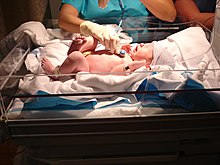Newborn


A newborn is a child after birth up to the age of four weeks. The term infant , on the other hand, is used for the entire first year of life.
Stage of development
At birth, the median weight of girls is 3.2 kg (5% percentile : 2.5 kg, 95% percentile: 4.0 kg), that of boys 3.3 kg (5% percentile: 2.6 kg 95% percentile: 4.1 kg). The weight of the children of multiparous women is on average around 85 to 140 grams higher than that of primiparous women (as of 1902). The birth length of newborn girls is 49.1 cm from crown to heel (5% percentile: 46.1 cm, 95% percentile: 52.2 cm), that of newborn boys 49.9 cm (5% Percentile: 46.2 cm 95% percentile: 53.0 cm).
One differentiates historically
- Premature babies (also: premature babies ) with a gestation period of less than 37 completed weeks
- Full term infants with more than 37 but less than 42 completed weeks of gestation
- Transmitted newborns with more than 42 completed weeks of gestation
More meaningful is the indication of the completed weeks of pregnancy, which, with today's options in neonatology, together with the birth weight, say more about the possible morbidity or mortality .
After birth, in order to avoid a lack of oxygen, the newborn's lungs must first expand and sufficient heat must be guaranteed. According to this, a statement about the maturity is possible based on the appearance of the skin of the newborn, even if it was not possible to calculate the pregnancy week. Children born prematurely are still covered with the so-called cheese smear ( vernix caseosa ), which is formed around the 27th week of pregnancy, reaches its peak around the 36th week and usually disappears completely around the 40th week. Due to the lack of vernix, transferred children usually have dry and cracked skin, which is also known as washerwoman's hands .
Adolf Portmann describes the degree of development of the human newborn baby who is ready for delivery as "physiological premature birth" in comparison to the newborns of other primates .
Legal situation
Even unborn life is protected in many legal systems. So is z. In Germany, for example, an abortion ( termination of pregnancy ) is only exempt from punishment until the end of the 12th week after conception and usually only after a prior consultation. A termination of pregnancy at a later point in time violates Section 218 of the Criminal Code, which is intended to protect the life of the unborn child.
From birth, human rights apply to newborns in most countries and cultures around the world .
Occasionally discussed, newborns with disabilities have the legal status of an embryo or fetus to leave, a killing due to medical or embryopathischer indication leaves unpunished. This is to enable a decision on the life of the newborn if necessary legally to terminate or not to get ( neonaticide ), for example when the parents even at a prenatally diagnosed disability for an abortion would have decided. Two proponents of this opinion are Peter Singer and the British bioethicist John Harris, who, like Singer, takes the view that in the case of severely disabled newborns, "it is not plausible to assume a moral change during the journey through the birth canal " when there is prenatal killing would have been legal through abortion. This view limits the impact of human rights in a way that is alien to Western cultures. According to German criminal law, this would mean manslaughter or even murder. The protection of the health of the developing unborn child in the womb receives little attention from the legal side , while from the medical side conscientious prenatal care is offered and operated.
from history
The heaviest newborn baby ever reported was born at home on January 19, 1879 in Seville, Ohio . Anna Bates (1846–1888), who was 227 cm tall herself, was given birth to a child who weighed 10.6 kilograms and was 76 cm (71 cm, according to another source) tall. However, it died eleven hours later.
See also
literature
- Alice Bolster et al. a .: Motherhood. 101 tips for mothers of newborns . 1999.
- Helga Kuhse, Peter Singer : Does this child have to stay alive? The problem of severely damaged newborns . 1993
- S2k guideline for the care of healthy, mature newborns in the maternity hospital of the Society for Neonatology and Pediatric Intensive Care Medicine (GNPI). In: AWMF online (as of September 2012)
Individual evidence
- ↑ The Newborn Child - Knowledge for Physicians. Accessed December 9, 2019 (German).
- ↑ Franz Daffner: The growth of people. Anthropological study . 2nd Edition. Engelmann, Leipzig 1902. pp. 125 f.
- ↑ who.int
- ↑ Harald Genzwürker, Jochen Hinkebein: Case book anesthesia, intensive care medicine and emergency medicine. Georg Thieme, Stuttgart / New York 2005, ISBN 3-13-139311-4 , p. 174.
- ↑ BBC News, January 16, 2004
- ↑ Guinness World Records 2006 p. 17, accessed January 18, 2010

